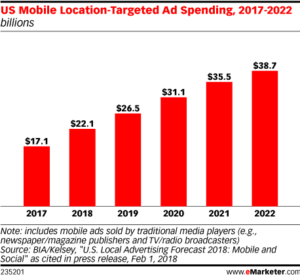Location-Based Marketing FAQs
May 17, 2019 by
In this article, Reveal Mobile answers a comprehensive list of the most frequently asked questions about location-based marketing for targeted ads. Below you will find an overview, use cases, examples of how location-based marketing works, as well as answers regarding campaign delivery and management and privacy. If you have any additional questions about location-based marketing or how Reveal Mobile’s VISIT products work, please contact us.
Overview & Use cases
What is location-based marketing?
Location-Based Marketing is a digital marketing strategy that serves advertising or content based upon someone’s current or previous location. For a more detailed explanation, read our blog post “What is Location Based Marketing?”
How does location-based marketing work?
Location-based works when people opt in to share their location with a mobile app that is on their smartphone. Next, that location data is either used in real-time to serve an ad, location-based content or a push notification, or the data is matched to a real-world point-of-interest (a business location) to create a historical audience segment for advertising at a later time. Lastly, marketers create audiences based on those segments and deliver relevant ads to the mobile devices.
On what screens can marketers serve location based ads?
Because location data is primarily tied to mobile apps, it’s easiest to reach location-based audiences on mobile devices. You can also reach location-based audiences on Facebook, Instagram, Snapchat, and Twitter through their own targeting tools, or by uploading a list of mobile advertising IDs as a custom audience. There are also companies, such as data management platforms and audience marketplaces, that match mobile advertising IDs to cookie-based data from desktop computers. This allows for marketers to reach location-based audiences across just about any screen.
What are the differences between geotargeting, geofencing, and geoconquesting?

Geofencing is creating a virtual barrier around a location. This can either be a radius around a large location, or a very specific building footprint. The word “geofencing” can also be used to refer to advertising when someone enters that virtual barrier. They may receive an alert, push notification, or an ad within a mobile app based upon that current location.
Geotargeting refers to delivering ads to people that are currently in, or were previously in, a specific location. Most of the time geotargeting refers to serving ads based upon historical location visits to points-of-interests, rather than serving ads in real-time, which is more commonly known as geofencing campaigns.
Geoconquesting refers to serving ads to people when they are currently in, or were previously in, a competitor’s location or locations.

What are some examples of companies using location based marketing?
BIA Advisory Services forecasts that marketers will spend over $31 billion in 2020 on location-targeted ads, which means there are thousands of companies and brands using location-based marketing to reach their desired audiences. These companies range from clothing companies to fast casual dining to creative and marketing agencies on behalf of the brands they represent. They typically want to reach audiences that visit their own locations, or competitive locations.
To learn more, check out one of these three resources:
- Post: What Works and What Doesn’t in Location-Based Marketing
- Case Study: Finding Elvis
- Case Study: Geotargeting for Black Friday (form required)
What types of data are used to create location-based audiences?
The primary data used to create a location-based audience is GPS data collected by mobile apps. This data takes the form of latitude / longitude coordinates which is then matched to  a real-world point of interest. Points-of-interest are business and retail locations, not home addresses. Other data signals that marketers can use for location include Bluetooth beacons, IP addresses and WiFi networks in order to determine location. As is the case with all location data, a person must grant permission to an app to share this information.
a real-world point of interest. Points-of-interest are business and retail locations, not home addresses. Other data signals that marketers can use for location include Bluetooth beacons, IP addresses and WiFi networks in order to determine location. As is the case with all location data, a person must grant permission to an app to share this information.
For example, the lat/long coordinates for The Washington Monument in Washington, D.C. are 38.8895° N, 77.0353° W. The data received is then matched to a “point-of-interest” in a database, in this case the Washington Monument, and the data is then able to be converted into audience segments.
How is location data matched to a device? Both Apple and Google allow app publishers and their advertising partners to use a specific identifier for collecting data for the purposes of advertising and product improvement. The industry uses the term Mobile Advertising ID (MAID, for short). Apple calls their identifier the IDFA, or Identifier for Advertising. Google’s is the AAID, or Android Advertising Identifier.
Is a mobile advertising ID (MAID) the same thing as a device ID?
MAIDs are a completely different identifier than the device’s ID that the manufacturer gave to the phone. The user can reset the MAID on their phone at any time, but couldn’t reset their actual device ID. Every time you get a new phone, you get a new MAID as well.
Campaign Delivery and Management
How do marketers import location-based audiences get into Facebook, Instagram, Snapchat or Twitter?
These social media platforms allow marketers to upload other data sources to their ad platforms. They then match the data from these audiences to their own user base, which requires an identifier to match against. In the case of location-based audiences, the identifier is the mobile advertising ID. Check out our guide to building custom audiences for more about this process, what works, and what doesn’t. For more information read our whitepaper, “A Guide to Building Custom Audiences on Social Media”
What is a DSP?
A DSP, or demand-side platform, is a solution to easily go in and buy advertising inventory across the advertising ecosystem. DSPs manage real-time bidding to determine the best impressions to serve your ad against. Examples of DSPs include Centro and AppNexus. For a complete overview of the ad tech landscape, check out this Prezi Business presentation.
What is cross-device matching and how does it apply to location-based marketing?
Cross-device matching refers to identifying the devices a person might use in order to deliver ads to an audience across their smartphones, desktop computer or smart TV. Some companies provide a service to match the mobile advertising ID, captured when opted-in location data is collected, to their cookie profiles received from their desktop computers. By matching these together, a location-based audience could receive relevant ads across their various devices.
Why do the numbers in a location-based audience not match the actual traffic, or expected traffic, that a location might normally receive? What’s going on if the reporting numbers don’t match what my clients think they should be?
There are two things that typically impact audience size: The number of devices a company can actually detect, or the measurable audience, and the methodology for measuring foot traffic and store visits.
What are location-based marketing tools?
A location-based marketing tool allows you to run and measure location-based marketing campaigns within your business efficiently.
There are many types that you can access to reach your audience based on their location.
- IP address marketing. This is the simplest and most common location-based marketing type because every computer or device connected to the internet has an IP (internet protocol) address. It allows you to target users based on their IP address location.
- GPS marketing. Almost every mobile device uses some form of GPS location technology to track a user’s location. This capability powers popular such as map apps, weather, news, and sports apps, shopping, restaurant, and retail apps, and travel and hospitality apps. With GPS marketing, you can target mobile users with a specific promotion based on their location.
- Geofencing marketing. Similar to GPS marketing but also allows you to set up virtual locations or geofences. You can then market to people who visit that location.
- Beacon marketing. Uses physical devices usually inside of a store or business to target promotions to people who are within range of the beacon.
What is location-based social media marketing?
Location-based social media marketing uses geotargeting tools that allow you to use location-based audiences for social media ad platforms such as Facebook, Instagram, TikTok, etc.
Using Facebook as an example, you can create a campaign based on store traffic that allows you to target audiences who have visited a specific store or chain. You can target at the individual location level or at the regional and national levels. You can also measure the results of your campaign by seeing who visited your target locations during and after your campaign.
Accessing this type of information on your own is almost impossible to do without the right tools, so implementing location-based marketing that’s focused on driving foot traffic to your locations via paid social will help you streamline the process and provide accurate results.
Some of the tools available include:
- MomentFeed. If you’re a brand that has a significant national presence, this tool allows you to connect with local consumers within specific communities.
- Uberall. This tool helps retailers capitalize on ‘Near Me’ conversions by offering a solid location marketing solution. With Uberall, your company can directly impact the online to offline journey and drive recurring revenue.
- VISIT Local. This product enables agencies, retailers, brands, and media companies to apply powerful, precise location data to improve ad campaigns. It’s the one tool for managing the three keys to motivating ideal customers — knowing who they are, reaching them based on where they go, and measuring campaign impact on their actions.
MEASUREABLE AUDIENCE
In order to build a location-based audience, someone must have an app on their phone that they’ve agreed to share location with, and the marketing company must receive a location signal while they’re in that location. This impacts the measurable audience size.
METHODOLOGY
Marketers either create location-based audiences by using exact polygons to capture a location’s true footprint or by placing a radius around the location. When a device is seen inside that geofence with enough confidence in the accuracy of that signal, companies mark that as a visitor to the location. Using exact polygons versus a radius creates much more accurate audiences, but typically means that the audiences are smaller than what most advertisers expect. If the audience numbers are significantly bigger than what’s expected, that usually means the polygon around the building footprint is incorrect, or radius-based measurement is employed.
Data and Privacy
Do location-based marketing companies know the identities of individual people?
Location-based marketing companies use mobile advertising IDs which do not give them the means to know the individual identity of the person with that ID. Overall, advertisers and the advertising ecosystem have no desire to know or take action on an individual level data. Those in the industry are instead interested in advertising to audience segments as a whole. Additionally, the ad tech ecosystem seeks to protect individual privacy, and therefore don’t offer products that provide visibility down to a single person.
While the US doesn’t consider the mobile advertising ID to be personal information, the European Union’s new Global Data Protection Regulation (GDPR for short) does. For more information, check out Reveal Mobile’s privacy policy

How can people opt-out of sharing their location?
There are numerous ways to opt-out of sharing location data. First, both Apple and Google have settings that allow you to limit or block data collection for advertising. Turning this setting on will block or limit data collection across all of your apps. You can disable location sharing with specific apps by reviewing the settings for each app, or by choosing to not share location when prompted after first downloading the app, or by uninstalling the app.
Companies typically also provide opt-out instructions in their privacy policies, just as we do. For example, you can email optout@revealmobile.com and provide us with your mobile advertising ID, and we’ll opt it out from our database. We don’t collect any email addresses, names, or phone numbers from mobile apps, so we need the mobile advertising identifier to find your device in our database. This blog post provides helpful tips on how to find your advertising identifier.
To learn more about opt-out choices, we recommend reviewing the Network Advertising Initiative’s article on “Information on Opting-Out on Mobile Devices”.
Questions for Reveal Mobile
How are you different from your competitors?
At the top level – we focus on three big things. First – We built VISIT Local to help sales teams early in the sales cycle. They use our reporting to bring to clients to help them visualize and take action on their foot traffic, and build audiences from competitors’ foot traffic. Second – customers love the flexibility & customizability of our platform. We don’t lock companies into using our system for campaigns, since we’re just the audience & analytics provider. We make it easy to customize audiences, locations, and date ranges to create exactly the geotargeted audience you’re looking for. Finally – our attribution reporting measures the audiences that you’ve built during and after the campaign. This allows you to see changes in foot traffic for that audience, if you’re winning foot traffic from competitors, and from which competitors.
Do you have conversion zones?
We do provide attribution reporting based upon audience foot traffic. This data is available anytime for the audience you’ve built, and centered around your campaign’s dates.
Do you deliver the campaign?
No, we’re just the audience and analytics provider. We let you take or push the data wherever you need to. That flexibility is one of the reasons customers love working with us. See examples of available DSPs.
Which DSPs do you work with?
Right now we have integrations with 10 DSPs, with a simple process for us to add others based upon customer requirements.
What steps does Reveal Mobile take to ensure privacy?
We stay on top privacy changes through a number of ways.
- We are members of the Network Advertising Initiative, undergoing annual privacy audits in order to stay members in the NAI, and adhering to their Code of Conduct
- We are members of the privacy and policy committees in the Mobile Marketing Association and the Interactive Advertising Bureau, and are registered vendors in the IAB’s Transparency & Consent Framework.
- We are also members of the Future of Privacy Forum, which provides excellent guidance on upcoming privacy regulations and legislation.
To find out more about location-based marketing or to set up a demo, contact us.


